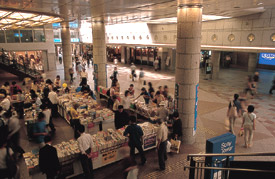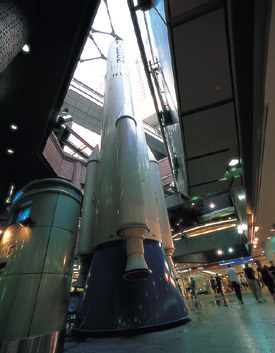 |
|
NIPPONIA No.23 December 15, 2002
|
|
Special Feature*
A Pleasant Environment,
Underground
In the center of almost every large city in Japan you'll find an underground concourse. Some of them are busy subterranean shopping districts, others crowded passageways conveniently linking railways stations and nearby buildings. These underground "streets" use valuable land efficiently and offer attractive space to enjoy. Here, we will look at how one city, Osaka, is developing below the ground.
Written by Hashizume Shinya, Assistant Professor at the Graduate School of Literature and Human Sciences, Osaka City University
Photos by Sugawara Chiyoshi, Map: Oguro Kenji

|
|
 |
 |
Top: Temporary tables are often set up at the Cascade Plaza in Crysta Nagahori, to offer goods that will attract passers-by.
|
|
Above: Water flowing at Trevi Plaza in Hankyu Sanban Gai. The cascading water counteracts the impersonal atmosphere often typical of underground passageways.
Right: Rocket Plaza in Nanba City features a rocket about 33 m high reaching up toward the atrium ceiling.
|
Cities grow up, and down
In the 20th century, architects used innovative construction techniques to develop artificial space in large cities. New space was created by building office skyscrapers, high-rise apartments and underground passageways. By building both up and down, urban land can be used very effectively.
The first underground retail concourse in Eastern Asia opened under Ueno Station in Tokyo, in April 1930. Called "Subway Store," the concourse offered basic necessities at discount prices and restaurants with everyday menus. The main aim of developers was to make the area more convenient for customers, especially commuters.
In Osaka around the same time, there was a plan to build a subterranean shopping concourse beside the Nanba subway station. However, the idea was abandoned because of opposition from merchants above ground, who were afraid they would lose customers. Later, around 1940, three different types of underground facilities—Hanshin Electric Railway's underground station at Umeda, the Umeda subway station, and Hankyu Department Store's basement retail floor—were all linked together by one great subterranean passage. This became the prototype for the underground city.
In 1942, in an article entitled "Osaka Below Ground Level," the well-known journalist Kitao Ryonosuke wrote that Osaka's underground concourses were, more than anywhere else, a "chaotic, uncontrolled mixture completely diverging from the expected." At the time, railroad companies and department stores were posting their own directional signs in underground passages, without coordinating with one another, and this led to the chaos Kitao described. He also wrote that all buildings in the Osaka inner city of the future might be linked together by underground passages, "creating a network of streets hidden from above." 
|
 |